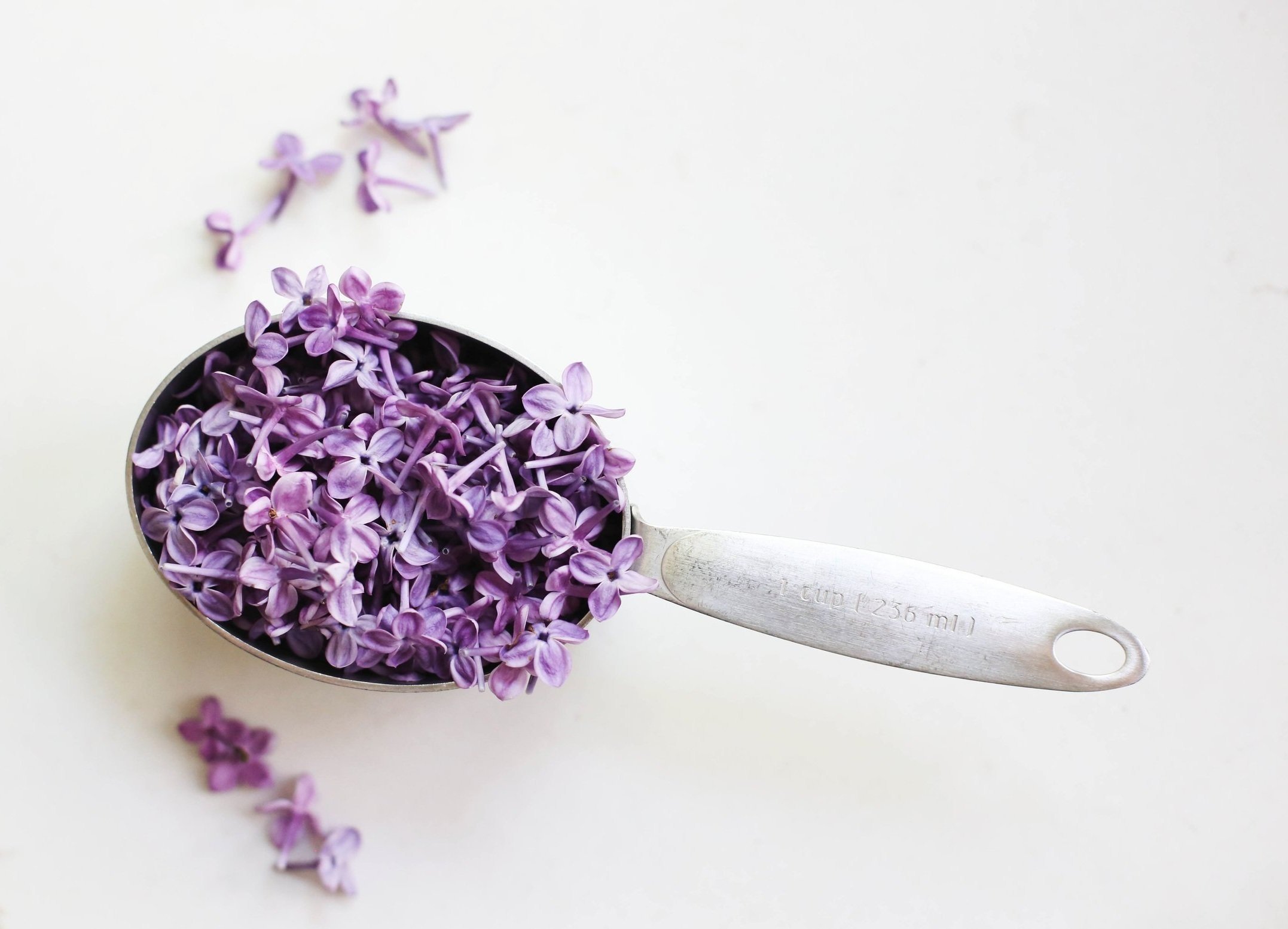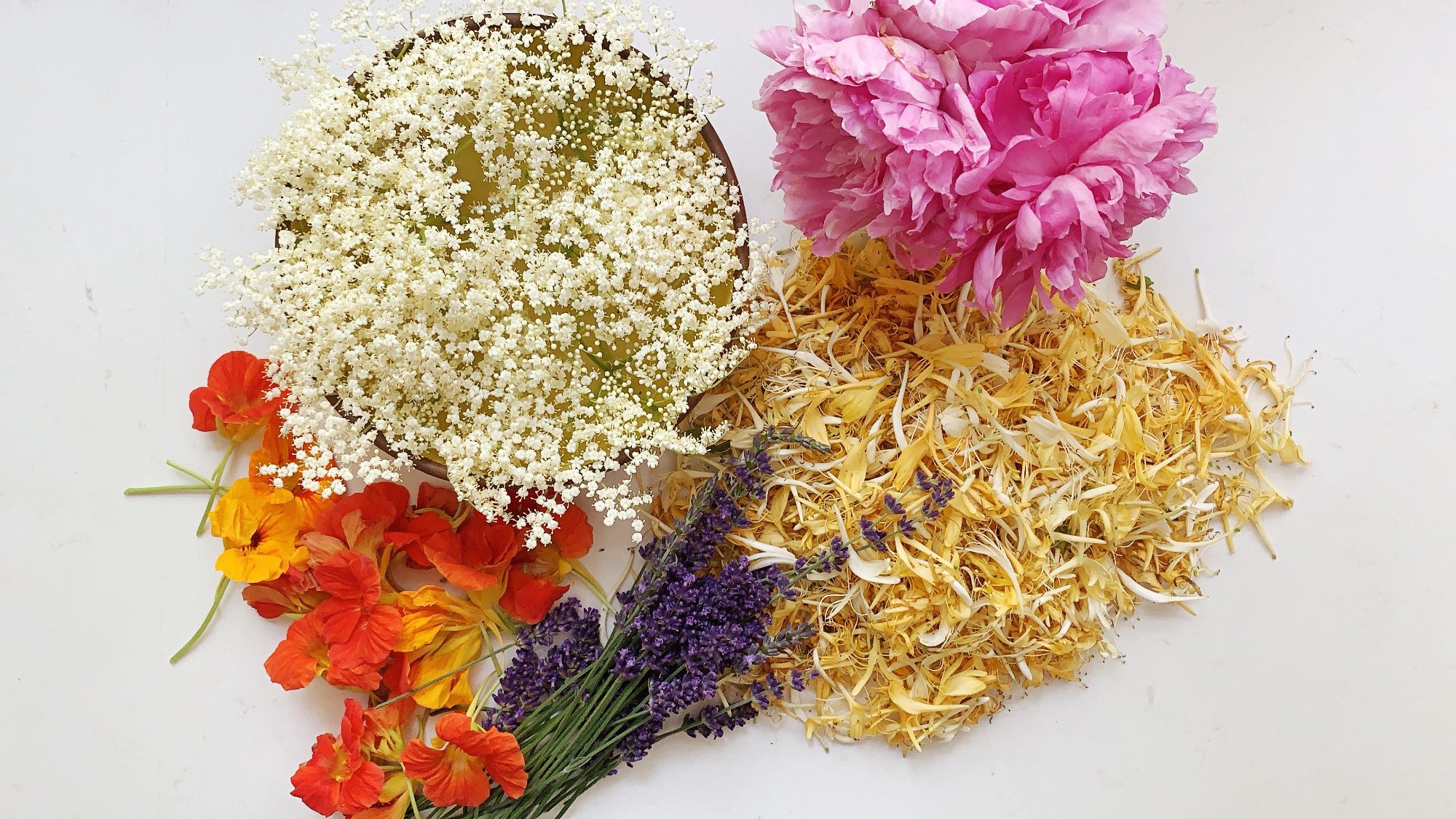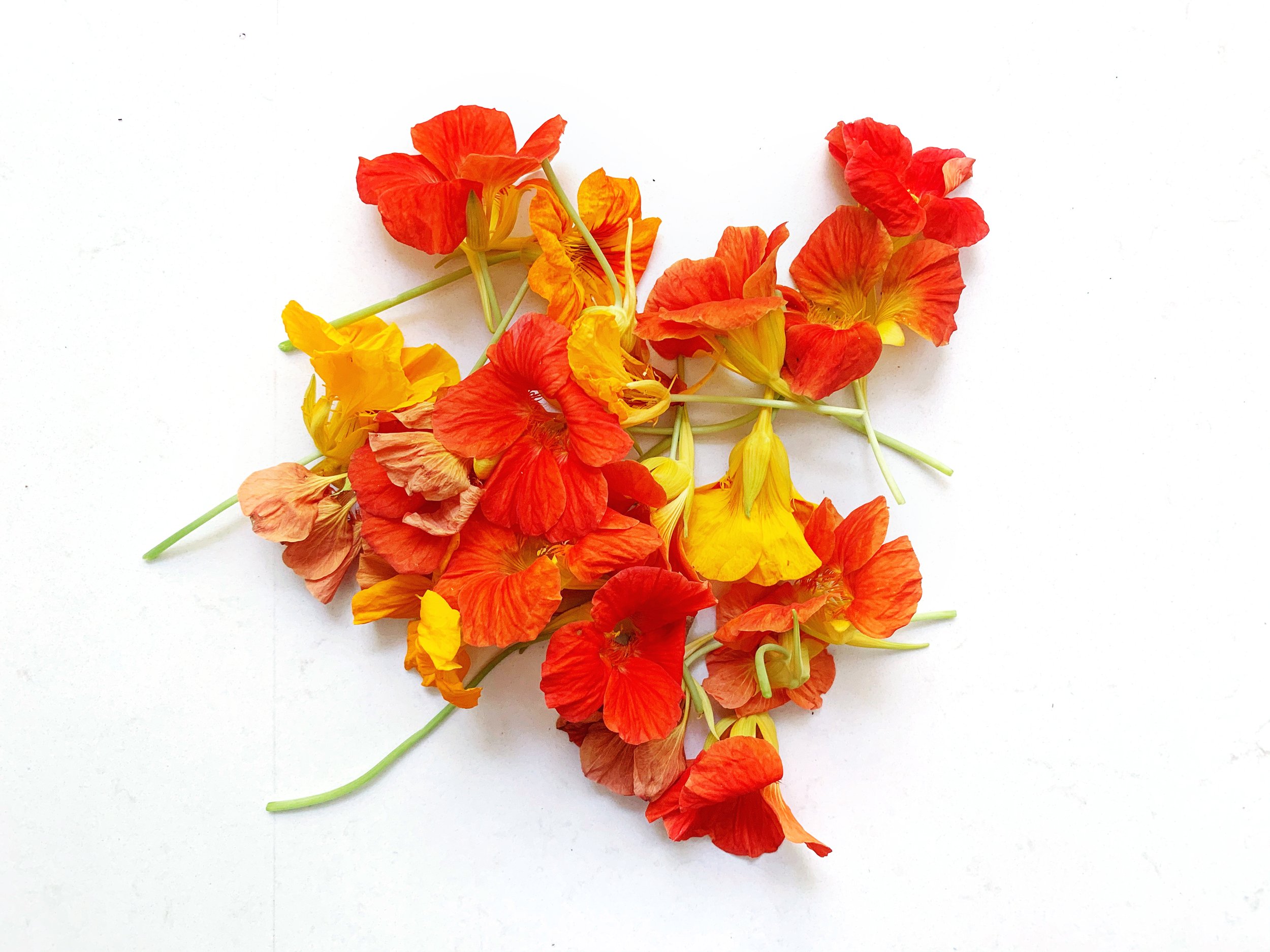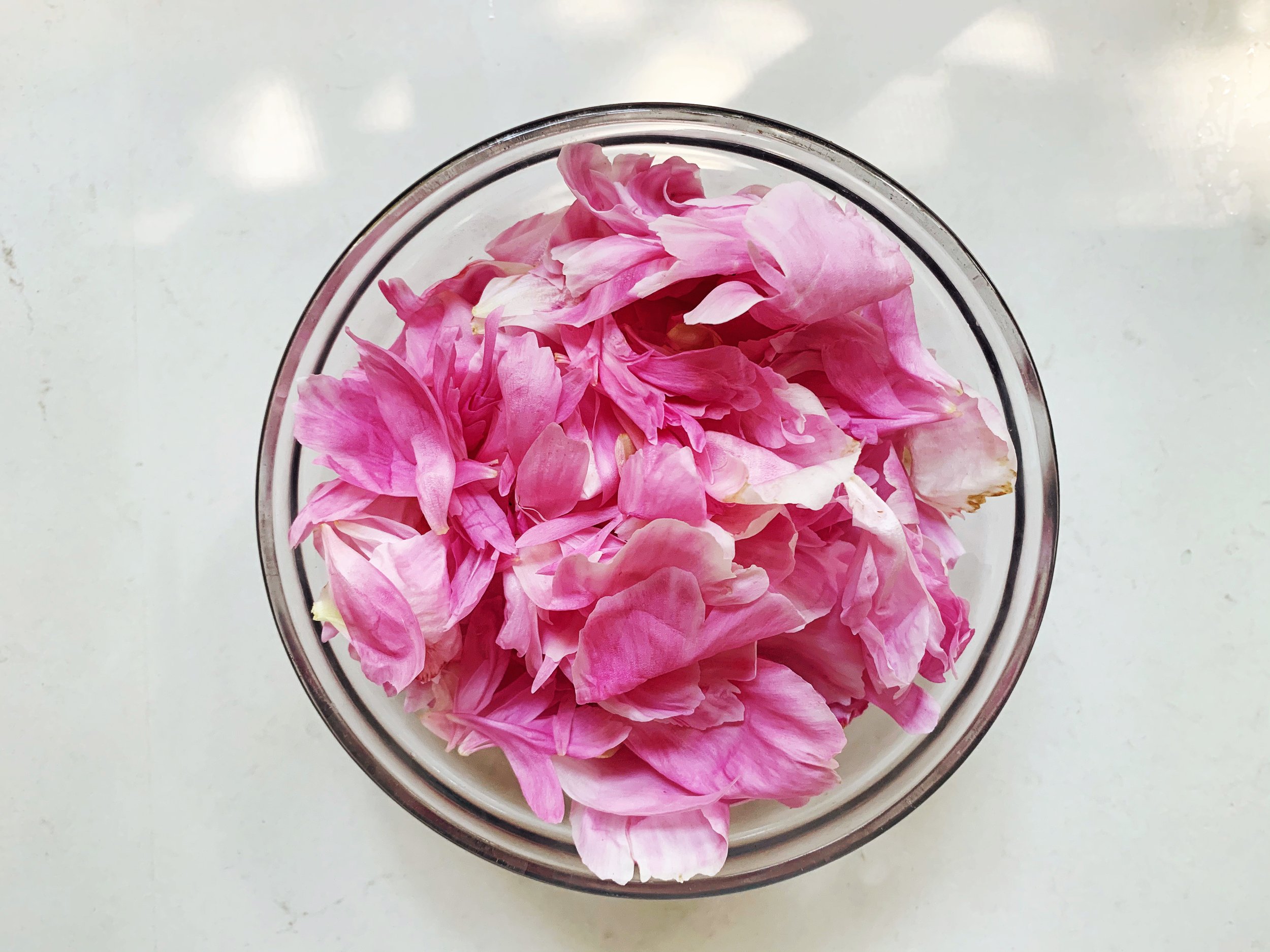
MAKE IT
Lilac-Flower
Syrup Recipe
by Superbloom contributor
Heather Crosby
Heather is a recipe developer, consultant, and educator specializing in plant-based, gluten-free good food for all eaters.
She’s the founder of Good Food Cooking School and the author of the YumUniverse and Pantry to Plate Cookbooks.
A lover of all things plants, she can likely be found barefoot in her garden when she’s not creating, cooking, designing, making, or baking.
Where you can find Heather
Have you ever smelled lilac blooms and they’re so intoxicating that you want to actually take a bite out of them?
Well, a) you’re not alone, and b) you can!
Lilac syrup is a versatile springtime treat that you can also use as a base for a variety of flowers all throughout the growing season.
Try honeysuckle syrup, nasturtium syrup, peony syrup, and more. Enjoy it on everything from cake and ice cream to cocktails and mocktails.
Lilac-Flower Syrup
Prep time: 10 minutes
Cook time: 5 minutes / Passive time: 3 hours
Servings: 10+ servings
Ingredients:
1 cup water
1 cup cane sugar
1 cup lilac blooms (packed cup)
Recipe Steps
Carefully remove the blooms from the lilacs and set aside. You only want to use the blooms, no green bits or stems.
Now, in a large pot, bring the sugar and water to a boil over medium-high heat, whisking constantly. Once the liquid reaches a boil, reduce the heat to a vigorous simmer and stir constantly for 2 more minutes until all the sugar is dissolved.
Remove the syrup from the heat and allow it to cool for 15 minutes—you want a cool steep of the flowers. Make sure that you allow the syrup to cool before you pour it over the lilac blossoms. If the mixture is too hot it will cook the flowers which can impart a muddy, earthy, decayed flavor to your syrup. While the syrup cools, fill a 16-oz jar with the flowers.
After the syrup has cooled, pour it over the flowers and use a spoon or silicone spatula to press and stir them so they’re all underneath the syrup. Cover the jar with a lid and set aside for 2 hours. A few times during this time, stir and press the blooms back under the syrup.
After two hours, taste the mixture, it should have a fresh and bright lilac flavor. At this point you can strain out the flowers, or you can allow the flowers to steep one more hour, but no longer (see Lilac Syrup Tips for reasons).
Strain the flowers and syrup through a sieve into a bowl and press the flowers to extract all the syrup. Transfer the syrup back to the jar and seal to store or serve right away.
Video showing how to make lilac syrup
Storage
When not using, refrigerate the syrup for up to 2 months.
You can freeze the syrup for up to 5 months, but we recommend enjoying it fresh within 2 months. Some freezers can impart off flavors.
Zero-Food-Waste Tips
Compost the strained flowers.
Blend the soaked flowers into a pint of melted vanilla bean ice cream and refreeze for “lilac” ice cream.
Lilac Syrup Tips
This syrup yields a deep golden or amber color, unless your variety of lilacs imparts purple color. You can always add a drop of natural red, blue, or purple dye if you want “lilac” color in your syrup.
You can also garnish a syrup-drizzled dish with some of the lilac flowers for extra prettiness and more lilac flavor.
Don’t over-steep the lilacs—3 hours is plenty of time. If over-steeped the flowers can begin to break down and impart decaying flower flavor to your syrup—like the water in the bottom of a 3-day old vase. Taste your syrup at the 1-hour and 2-hour mark to monitor the infusion. When the mixture has a slightly sweet lilac flavor, strain and refrigerate, or use right away.
Make sure that you allow the syrup to cool before you pour it over the lilac blossoms. If the mixture is too hot it will cook the flowers which can impart a muddy, earthy, decayed flavor to your syrup.
Be sure to source organic, food-grade lilacs with no pesticide exposure.

Ingredient Substitutions
Lilacs: you can try any edible flower instead of lilacs like roses, honeysuckles, nasturtiums, peonies, elderflowers, marigolds, magnolia, dandelions, and lavender.
Cane sugar: you can use honey instead. If you do, use ½ cup honey per 1 cup lilacs and 1 cup water instead, since honey is sweeter and adds a more distinct honey sweetness to the final result.
Variations
You can add a 1″ x 2″ strip of lemon zest to the syrup as it boils and simmers. Allow it to cool and infuse with the flowers—lemon adds complexity, brightness, and a slight lemon flavor that cuts the sweetness of the syrup.
Have some fun with complimentary spices: a pinch of cardamom, pink peppercorns, and even saffron can add magical nuance to syrups. Try it in combo with the lemon zest, too.

Ways to Enjoy Flower Syrups
Cake and cupcakes: drizzle some syrup over cake to moisten and add flavor. Then, if you’d like, frost and/or decorate with some of the flowers.
Matcha latte: use syrup to sweeten the matcha or the milk. Place a few blossoms on top!
Ice Cream: pour some syrup over vanilla ice cream or lemon sorbet & garnish with flowers.
Lemonade: use the syrup to flavor store-bought lemonade or to sweeten and flavor homemade lemonade.
Recipes with strawberries, blueberries, or lemon: lilac syrup works well with these flavors, so be creative!
Ginger ale: give some spring flavor to a glass of ginger ale with lilac syrup.
Spritz: use a 1:1:2 combo of syrup:lemon juice:club soda (or champagne) for a lilac spritz.
Champagne: give some special flavor and sweetness to a glass of champagne with a splash of lilac syrup.
Scones, doughnuts, & pastries: sweeten the dough or the icing for baked goods with lilac syrup (and maybe decorate with some blooms).
Whipped cream: add some syrup to whipped cream.
Cocktails: use lilac syrup in combination with neutral-flavored spirits like vodka.
Custard: use lilac syrup to sweeten custard bases or to drizzle over a finished custard or panna cotta
Yogurt: stir some syrup into yogurt.
Fruit salad: toss fresh fruit like berries with some syrup for unique flavor.
Membership Offer for Good Food Cooking School
Learn how to make your own plant-based, gluten-free ice creams; yogurts; baked goods like pastry, breads, and cakes; fermented beverages like ginger ale; and much more to serve with your lilac syrup at GoodFoodCookingSchool.com.
Superbloom friends can use code SUPERBLOOM for $25 off Good Food Cooking School sign up—access hundreds of recipes, meal plans, and self-paced courses.
Image & video credits: Heather Crosby
We respect your privacy, and when you click “Sign Up,” you are confirming that you agree that information you submit will be protected and used as permitted in our privacy policy and terms. If you do not agree to any of these terms, you may not submit this form.












